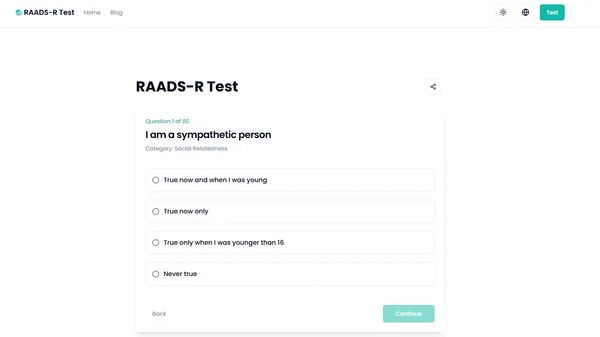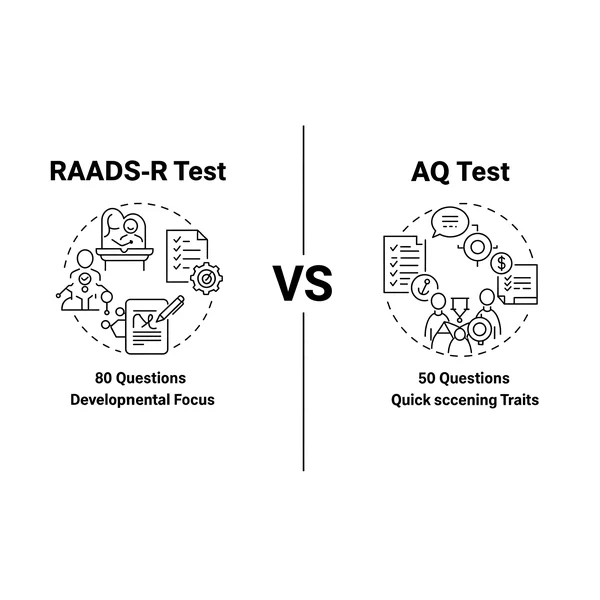RAADS-R vs Other Autism Tests: A Comprehensive Comparison Guide
May 17, 2025 | By Elara Vance
Navigating the world of autism assessments can feel overwhelming, especially for adults seeking clarity. With various tests available, you might be wondering, "how to choose an autism test for adults?" or specifically, how the RAADS-R test stacks up against other common options. This article provides a clear and detailed autism test comparison, focusing on the RAADS-R, the Autism-Spectrum Quotient (AQ) test, and the Autism Diagnostic Observation Schedule (ADOS), to help you understand their unique roles, strengths, and limitations in adult autism assessment. Our goal at raads-r.net is to empower you with comprehensive information for your self-discovery journey, enabling you to make informed decisions about your next steps.
Understanding the RAADS-R Test: Its Role in Adult Autism Assessment
Before diving into direct comparisons, it's essential to have a solid understanding of what the RAADS-R (Ritvo Autism Asperger Diagnostic Scale-Revised) offers. It has become a widely recognized tool for many adults beginning to explore whether their experiences align with the autism spectrum.
Key Features of the RAADS-R: A Detailed Self-Report Screening Tool
The RAADS-R test is a comprehensive self-report questionnaire comprising 80 questions specifically designed for adults (typically 16 years or older, though most validated for 18+). It meticulously explores traits across four primary domains:
- Social Relatedness: This section assesses difficulties with initiating and maintaining social relationships, understanding social cues, and reciprocal social interaction.
- Language: This delves into challenges with both expressive communication (how one speaks) and receptive communication (understanding what others say), including literal interpretations and pragmatic language use.
- Sensory-Motor Experiences: This domain covers heightened or reduced sensitivity to sensory stimuli (like sounds, lights, textures, smells, tastes) and any repetitive motor mannerisms or unusual motor coordination.
- Circumscribed Interests: This explores the presence of intense, highly focused, or unusual interests and a strong need for routines or sameness.
As a screening tool, its primary purpose is to help individuals identify and quantify potential autistic traits that may warrant further professional investigation. It offers a structured framework for self-reflection. You can experience this detailed self-assessment on our site to begin your exploration.
Intended Use and Target Audience of the RAADS-R
The primary target audience for the RAADS-R is adults who suspect they might have autism but have not received a formal diagnosis. This often includes individuals who may have "masked" traits for years or whose presentation of autism might not fit stereotypical portrayals. Its intended use is for initial self-exploration, providing a structured way to reflect on lifelong patterns of behavior and experience relevant to established autism diagnostic criteria. What are the limitations of the RAADS-R test compared to others? This is a crucial question we'll address as we compare it with other instruments, as no single online autism test is a complete diagnostic solution.

The RAADS-R Test vs. The Autism-Spectrum Quotient (AQ) Test: A Closer Look
A frequent query among those researching autism screening tools is "what is the difference between raads-r and aq test?" Both are widely used self-report measures, but they have distinct characteristics.
Comparing Test Format and Question Focus (RAADS-R vs. AQ)
The AQ test, developed by Simon Baron-Cohen and his colleagues, is generally shorter than the RAADS-R, typically containing 50 questions (though shorter versions like the AQ-10 exist). It aims to quantify where an individual falls on the continuum from autism to neurotypicality by assessing traits across five domains: social skill, attention switching, attention to detail, communication, and imagination. While both utilize a test format involving self-rated statements on a Likert-type scale, their question focus and depth differ. The RAADS-R delves more deeply into developmental history (asking about traits "now and when young") and a broader range of clinically relevant symptoms, often with more nuanced phrasing. The AQ provides a more general measure of autistic-like traits.
Strengths and Limitations of the AQ Test for Adults
The AQ test's strengths undeniably include its brevity, ease of administration, and widespread availability, making it a quick initial screener. It has been used extensively in research. However, its limitations are also important to consider. Some critics argue it might be less sensitive to the more subtle presentations of autism, particularly in adult women, or in individuals who have developed strong camouflaging strategies. Furthermore, like any self-report, its accuracy depends on the individual's self-awareness and honesty. Understanding these nuances is vital when considering various autism screening tools.
When Might the AQ Test Be a Suitable Alternative or Complement?
The AQ test can be a suitable alternative if a very quick, general indication of autistic traits is desired. It can also serve as a complement to the RAADS-R; for instance, if an individual scores high on both, it might strengthen the indication for further professional assessment. However, for individuals seeking a more thorough self-assessment that considers developmental aspects and a wider range of symptomatic experiences, the RAADS-R generally offers greater depth.

The RAADS-R Test vs The ADOS-2 (Autism Diagnostic Observation Schedule): Understanding the Diagnostic Gold Standard
Comparing the RAADS-R test vs ADOS is fundamental because they represent different tiers of assessment in the diagnostic process. Many users ask, "is raads-r or ados better for adult diagnosis?"
Key Differences: Self-Report Screening vs. Clinically Administered Observation
The most significant difference lies in their methodology: the RAADS-R is a self-report screening tool filled out by the individual, reflecting their subjective experiences and perceptions. In contrast, the ADOS-2 (Autism Diagnostic Observation Schedule, Second Edition) is a semi-structured, standardized assessment involving direct clinical observation of an individual's social interaction, communication, play or imaginative use of materials, and restricted and repetitive behaviors by a trained clinician. This distinction is central to understanding adult autism assessment pathways. The ADOS-2 involves a series of "presses" or planned social situations designed to elicit behaviors relevant to an autism diagnosis.
ADOS-2 as a Diagnostic Tool: Purpose, Administration, and Scoring
The ADOS-2 is widely considered a "gold standard" diagnostic tool for autism across different ages and developmental levels. Its purpose is to provide objective, standardized data on an individual's behavior in specific social contexts. The administration is interactive, with the clinician presenting various activities and observing the individual's responses. The scoring is based on these observations, using a detailed coding system. It is a time-intensive and costly assessment that requires specialized training to administer and interpret correctly.
Can the RAADS-R Replace an ADOS Evaluation? Which autism test is most accurate for diagnosis?
No, the RAADS-R absolutely cannot replace an ADOS evaluation, nor can any other self-report screener. Which autism test is most accurate for diagnosis would point towards comprehensive clinical evaluations that may include the ADOS. The RAADS-R provides valuable self-reported information and can be a useful part of the information gathering for a clinician, potentially guiding areas for further inquiry during a clinical interview. However, a formal diagnosis often incorporates direct observational data like that from an ADOS, alongside a thorough clinical interview, developmental history review, and collateral information (e.g., from family members, if available and appropriate).

Other Notable Autism Screening Tools & Questionnaires
While the RAADS-R, AQ, and ADOS are prominent, it's worth acknowledging that other autism screening tools and questionnaires exist, each with its own focus.
Brief Mention of the ASQ (Autism Spectrum Screening Questionnaire) & CAT-Q (Camouflaging Autistic Traits Questionnaire)
The ASQ (Autism Spectrum Screening Questionnaire) is often used for children but illustrates the variety of screeners available. More relevant for adults, especially those who might be "masking," is the CAT-Q (Camouflaging Autistic Traits Questionnaire). While not a primary diagnostic screener for ASD itself, the CAT-Q can provide valuable insights into the extent to which an individual might be consciously or unconsciously hiding autistic traits, which can be relevant when interpreting scores from tools like the RAADS-R. Understanding one's test format and scope is key.
Online Self-Assessments: Benefits, Cautions, and the Value of Resources like raads-r.net
Online autism tests, such as the RAADS-R offered on raads-r.net, provide immense benefits in terms of accessibility, privacy, and convenience for initial self-exploration. They can empower individuals to take the first step in understanding themselves better. However, cautions are paramount:
-
They are not diagnostic.
-
Results can be influenced by self-perception, current emotional state, and understanding of the questions.
-
They should never replace professional consultation if concerns are significant or if a formal diagnosis is sought. Websites like ours aim to provide these tools responsibly, with clear disclaimers and educational content to help users interpret results appropriately.

Choosing the Right Path: Which Autism Test is for You in Your Adult Autism Assessment?
With various adult autism assessment options available, understanding which autism test is for you depends heavily on your current goals and needs.
Matching the Tool to Your Needs: Initial Self-Exploration vs. Formal Diagnosis
If your primary goal is initial self-exploration, curiosity, or to gather information before deciding whether to seek professional help, a detailed self-report tool like the RAADS-R (available on raads-r.net) is a great starting point. It can help you articulate your experiences. If you are seeking a formal diagnosis for legal, medical, or support-access reasons, you must engage with a qualified clinician who will conduct a comprehensive diagnostic evaluation.
Understanding the Limitations and Strengths of Each Assessment Type
It's vital to understand the strengths and weaknesses of each assessment type. Self-reports like the RAADS-R and AQ are convenient but subjective. Observational tools like the ADOS offer objective data but are resource-intensive and require clinical expertise. No single autism test is a panacea; a multi-faceted approach is often best for a full picture. The accuracy claims of any single tool must be viewed within its intended scope.
The RAADS-R Test as a Comprehensive Starting Point for Adult Self-Assessment
The RAADS-R test excels as an accessible, detailed, and free starting point for adult self-assessment. Its focus on adult manifestations of autistic traits, including developmental history, makes it particularly useful for those exploring these possibilities later in life. It can help organize your thoughts and experiences, providing a structured basis for further reflection or for discussions with a professional. You can begin your RAADS-R self-assessment journey here.

Navigating Your Autism Assessment Options: RAADS-R & Beyond
Navigating autism assessment options can be complex, but understanding the distinct purposes, strengths, and limitations of tools like the RAADS-R test, AQ, and ADOS is an empowering first step. The RAADS-R, available on raads-r.net, serves as an excellent, free, and comprehensive resource for adults beginning their journey of self-discovery and exploring potential autistic traits. While it is not a diagnostic tool, it can provide invaluable insights and guide your next steps, whether that involves further self-reflection, seeking out community, or pursuing a professional evaluation.
What are your experiences with different autism screening tools or assessments? Do you have further questions about how to choose the right one for your needs? We encourage you to share your thoughts and questions in the comments below – your experience can help others on similar paths!
Comparing RAADS-R with Other Autism Tests
-
What's the main difference between the RAADS-R and the AQ test?
The primary differences lie in their length and depth. The RAADS-R (80 questions) is generally more comprehensive and delves deeper into developmental aspects and clinically relevant symptoms compared to the AQ test (typically 50 questions), which offers a broader, quicker measure of autistic traits. Both are self-report screeners for adults.
-
Is the RAADS-R test as accurate as a clinical ADOS assessment for diagnosis?
No. The RAADS-R is a self-report screening tool with good research backing for identifying potential traits. The ADOS is a diagnostic tool based on clinical observation by a trained professional and is part of a comprehensive diagnostic evaluation necessary for a formal diagnosis. They serve different purposes regarding accuracy for diagnosis.
-
If I score high on the RAADS-R, do I still need an ADOS or other clinical assessment?
Yes. A high RAADS-R score strongly suggests that a professional diagnostic evaluation is warranted to determine if you meet the criteria for Autism Spectrum Disorder. An ADOS may be part of that comprehensive clinical assessment, depending on the clinician's approach and your specific situation. The RAADS-R result itself is not a diagnosis.
-
Which autism test is best for an adult suspecting autism who is just starting to explore?
For initial self-exploration and understanding, a detailed, free, and accessible self-report tool like the RAADS-R test is an excellent starting point. It allows individuals to reflect on a wide range of traits from the privacy of their own home. You can take the RAADS-R test on our website.
-
Are online autism tests like the RAADS-R reliable enough to give me an idea if I should see a doctor?
Reputable online tests like the RAADS-R, when based on validated questionnaires, can be reliable screening tools to help identify if your reported traits align with those often seen in autistic individuals. If your score is high or you have significant concerns based on your results and life experiences, it is a good indication that you should consider discussing these with a doctor or mental health professional.